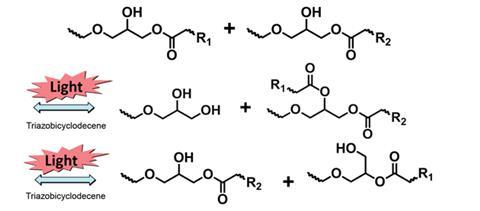Chinese chemists have created an epoxy that can be rapidly hardened and reshaped by shining a light on it. Unlike traditional epoxies which are cured using heat, this approach uses carbon nanotubes to translate light energy into localised heat to set the epoxy. Shining additional light on the set polymer initiates self-healing and reshaping.
Standard epoxies are epoxide containing polymers that form thermosets through a crosslinking reaction triggered by a curative agent. This study takes advantages of vitrimers, a recently developed form of epoxy that uses a thermally triggered transesterification reaction to form crosslinks, so the polymer can be reshaped without altering the number of bonds.

The team, led by Yen Wei and Yan Ji at Beijing University, integrated carbon nanotubes, which are known for their photothermal translation capacity, within a vitrimer with the aid of a polymer of intrinsic microporosity, called PIM 1, which acted as a dispersal agent. With sufficient light intensity, the carbon nanotubes provided sufficient heat energy to reach the toplogy-freezing transition temperature (the equivalent of the glass transition temperature) and allowed reshaping and restructuring of the epoxy in a matter of minutes or seconds.

Materials chemist Jyothirmayee Aravind, from Rowan University in the US, acknowledges the difficulty involved in reprocessing and welding thermosets such as epoxy, and says the work is ‘highly significant as it paves the way to practical applications of carbon nanotubes and vitrimers.’ Yang agrees, and adds that the team are looking to expand their research into practical applications such as remote welding and welding of heat sensitive components.
References
This paper is free to access until 17 June 2014. Download it here:






No comments yet